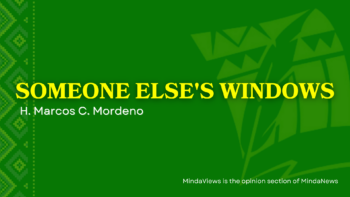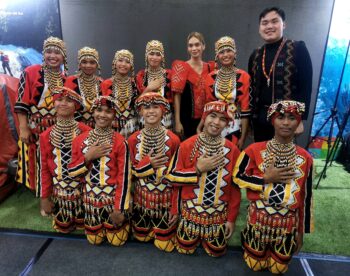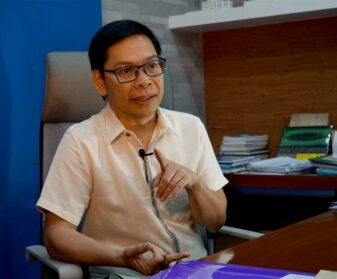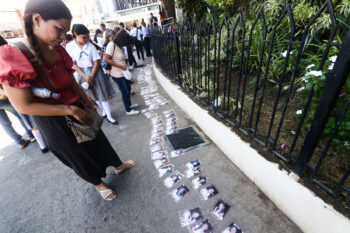QUEZON CITY (MindaNews/8 February) – The controversy surrounding the Charlie Hebdo cartoon has opened new tensions in the Muslim world especially in relation with the other. There was even a weird call from supporters of Charlie Hebdo for Muslims all over the world to do apology en masse.
Unlike in the past where instances of Islamophobia were rather isolated and limited in their impact, this time some world leaders joined the protest march in France and supported Charlie Hebdo even as they expressed strong position against perpetrators while stoking fear on Islamists engaging more violence in Europe.
Islamophobia
There had been many instances of Islamophobic cases especially major ones like Salman Rushdie’s “Satanic Verses,” Danish cartoons, the Fitna, the burning of the Holy Qur’an, the tearing down of minarets, video about the Prophet, and recently, the Charlie Hebdo’s pornographic (pardon my words) depiction of the Prophet.
There are underlying causes why we have reached this stage heightening anew the tension between Islam and the West. What characterized mainly all these Islamophobic materials are attempts to defame what is supposedly considered as sacred tradition.
While satire is, in some instances, accepted in many parts of the Muslim world as shown in classic works of al-Jahiz, Abu Nuwas and Nasreddin, today’s satire in the West took a totally distinct turn by becoming even more insensitive on symbols or signs related to religion.
Satire in the West is honed by long tradition of humanism and secularism that dated back even to early Greek. The intent is usually to make commentary on social and political issues in a way that could not be directly done again those in power. The origin of Charlie Hebdo, for instance, started with magazine Harakiri, a satirical work intended as social and political commentaries against French leadership in the ‘70s. Recently, due to increasing tension in the Middle East and the influx of Muslim immigrants in Europe, there developed resistance among locals by using satire as tools in discriminating migrant Muslims.
Charlie Hebdo would have not received such a controversy had it simply focused its commentaries on certain groups or people while risking ethnic and racial discrimination. But when Charlie Hebdo went beyond the line in desacralizing the sacred, then as if Islam and everyone else in the Muslim world are the ones being defamed.
There has to be sensitivity in terms of how we look at the tension elicited with this new kind of Islamophobia. For quite a long time, what is usually underlined as cause of controversy is clash of freedom of speech and freedom of the press vis-à-vis freedom to practice one’s faith and one’s religion.
The controversy is measured by the extent of one’s tolerance in allowing the right of the other to express his or her freedom and the extent of such freedom without infringing on other’s right to one’s faith or tradition. There are obviously some ways or mechanism where the tension could be resolved. In the West, there is strong tradition of civil liberty where people could express their rights and where laws provide some parameters where bundle of rights and its clashing tendencies is usually disentangled, weighed and resolved according to merits or demerits of cases on issues pertaining to discrimination. Unfortunately, legal institutions in some countries are ineffective in addressing Islamophobia.
Heirophany
We noted previously the tradition of sacred in Islam and how it is being viewed as cornerstone of Muslim faith. In this regard, any attack or defamation on sacred symbol could elicit reaction from many quarters. What we previously missed to highlight is the misunderstanding on the sacred in religious tradition.
Mercia Eliade in “The Sacred and the Profane,” advanced the idea of heirophany – that is, an act of manifestation of the sacred. It is a phenomenon that makes certain symbol or faith tradition becomes so intense as it shapes or defines a person’s belief. Eliade writes:
“It could be said that the history of religions – from the most primitive to the most highly developed – is constituted by a great number of heirophanies, by manifestations of sacred realities. From the most elementary heirophany – e.g., manifestations of the sacred in some ordinary object, a stone or a tree – to the supreme heirophany (which, for a Christian, is the incarnation of God in Jesus Christ) there is no solution of continuity. In each case we are confronted by the same mysterious act – the manifestation of something of a wholly different order, a reality that does not belong to our world, in objects that [are] integral part of our natural “profane” world (p. 11).”
What Eliade is saying is that there has to be certain understanding on how the concept of sacred works. Accordingly, it is the limitation of today’s modern Occidental. He writes:
“The modern Occidental experiences a certain uneasiness before many manifestations of the sacred. He finds it difficult to accept the fact that, for many human beings, the sacred can be manifested in stones or trees, for example…the sacred tree, the sacred stone are not adored as stone or tree; they are worshipped precisely because they are heirophanies, because they show something that is no longer stone or tree but the sacred, the ganz andere (p. 12).”
For sure, the uneasiness is deeply rooted. Eliade writes further:
“Modern nonreligious man assumes a new existential situation; he regards himself solely as the subject and agent of history, and he refuses all appeals to transcendence. In other words, he accepts no model for humanity outside the human condition as it can be seen in the various historical situations. Man makes himself, and he only makes himself completely in proportion as he desacralizes himself and the world. The sacred is the prime obstacle to his freedom. He will become himself only when he is totally demystified. He will not be truly free until he has killed the last god (p. 203).”
This view of Eliade explains the uneasiness and disrespect of today’s Occidental man on the sacred given that the West does not have the rich tradition of the East including the deep expression of spirituality in the Orient.
This view of Eliade identifies an important yet missing link in the debate on the right to practice one’s faith versus the right to free speech. It explains why proponents of satire including their use of cartoons are essentially insensitive, as they are prone to disrespect many religious traditions including Islam’s. In a sense, the series of Islamophobic cases could be explained with the fact that Occidental man suffers with ignorance of the sacred.
Double standard, maturity and creativity
When we say that there are venues where tension of this sort could actually be resolved, we felt that this is a way where we avoid polarization along religious or secular line amongst communities particularly in Europe. It means availing social, political and legal institutions where excesses on both sides could be addressed and possibly resolved with high degree of success.
Unfortunately, what surfaces even more is the continuing double standard in judgment of cases involving Islamophobia so that it convinces even more proponents of radical Islam to take the law into their hands as they respond callously to satirical provocation. On the contrary, if there is no maturity in the way Muslims respond to provocation, then they will become continuing object of Islamophobic attacks. It heightens the crisis and closes the avenue of civility to reign and for rule of law to become paramount.
When we advance the need to be creative in looking for avenues or strategies in confronting this malaise, we felt that for past years and decades Muslims had become easy prey to taunting and provocation even through non-sense cartoons and videos as if these are still taken seriously and especially with social media these days. They have not upgraded their ways in dealing with the other including their myopic view in seeking justice making them even more on the defensive. Their projection of Islam as they respond passionately and violently is that it is something intolerant that is not able to relate with civilized society.
When we invoke creativity and appropriate strategy in handling Islamophobia, we refer back to Suratu l-ahzab, the chapter of the Qur’an that speaks about the experience of the Prophet (SAW) and the sahabah (Prophet’s companions) and early Muslim community where they were practically confronted with threats and challenges from all fronts. The verses we read earlier are reminders of Prophet Muhammad (SAW) regarding his role and his attitudes amidst conspiracy that gripped them in Madinah. To reiterate, the Qur’an says:
“O Prophet! Truly We have sent thee as a Witness, a Bearer of glad tidings and a warner.
And as one who invites to God’s (Grace) by His Leave, and as a Lamp Spreading Light.
Then give glad tidings to the Believers that they shall have from God a very great bounty.
And obey not (the behests) of the Unbelievers and Hypocrites, and heed not their annoyances, but put thy trust in God. For enough is God as a disposer of affairs (45-48).”
This is a soothing reminder on the primacy of the Prophet’s life in terms of his role as bearer of glad tidings even as he is exhorted to carry firmness and absolute trust on Allah (SWT) and that he should not waiver despite annoyances from unbelievers.
The context of this surah is that after the Hijrah (migration), the Muslims were already in Madinah where Quraysh continuously attacked them. War ensued in the Battle of Badr two years after Hijrah. A year later, the Quraysh launched another attack in the Battle of Uhud where Muslims suffered many casualties. Few years therefrom, the Quraysh launched what is referred to as the ahzab, a confederacy to confuse the rather nascent ummah by engaging lots of annoyances against the Prophet; so that, by around 5 AH, there was another attack that resulted to what came to be known as the Battle of Khandaq. That time, the Muslims, through the advice from Salman the Persian, came up with strategy by digging up trench to repel the attacks of the Quraysh.
From political and military perspective, that experience in building trench shows creativity and utilization of appropriate strategy as a way to secure Muslim community. That experience was adopted in the 6th century. There must be countless instances of relatively similar experiences in succeeding historical epochs where relatively similar models, ways and strategies were done.
In our time, what is missing is the ability to strategize ways in properly addressing Islamophobia. Note that Muslims in Europe are, in a sense, engaged in hijrah (migration), albeit in different context. They are in a totally new situation as minorities. Therefore, their strategies should be such that these are framed in the context of their traditions, as they have to relate with new realities in countries where they presently live as new residents. It must be true whether they come from North Africa, Middle East, India subcontinent, Central Asia, Southeast Asia, and so on.
Certainly, many of them have already been acculturated, but there are still many from their quarters that have difficulty in living side by side with the other, while few of them could be vulnerable to influences from fundamentalist thinking thus radicalizing especially the youth. As such, it heightened even more the tension between proponents of Islamophobia and mostly young and radicalized Muslims that usually respond in kneejerk fashion to provocation. These are the realities where Islamophobic conditions thrived and worsened continuously.
Maximizing cultural space
For sure, the Muslim world today thrives in a grayer, increasingly complex zone or domain away from the dichotomy of the old world of daru l-Islam (Land of Islam) versus daru l-harb (Land of war). It is gray yet opened space. Therefore, there has to be ways where Muslims are able to maximize the use of such space. What they purport to advance must, in a way, be something that is received by the other more willingly not something that becomes a source of provocation given the Occidental ignorance with what Merciade refers to as “heirophany.”
As Muslims chose Europe today, they have to inevitably live side by side with the other. Their projection should be such that it is not simply framed by the thoughts and tradition they came from; it is something where they have to face with new reality. They have to respect rule of law, civil liberty, and so on. In a sense, people of Europe are now their new neighbors. They have to project confidence with high degree of respect and tolerance, where they cannot just be taunted with ordinary provocation and annoyances.
There is a hadith (saying) of Prophet Muhammad (SAW): “By Allah, his faith is incomplete. By Allah, he is not a perfect Muslim. By Allah, he does not believe. He was asked: O Messenger of Allah who is he? He said: One whose neighbors are not immune from his mischief.”
This hadith suggests that Muslims could suffer from mischief as they have their own excesses. They have to be careful with their actions not only within their own quarters and more especially toward the other and their neighbors. What the other sees of Islam is mirrored by how Muslims conduct themselves and how they deal with them.
In fact, the other side of this whole episode is that many immigrants from Muslim countries to Europe and the United States suffer from political persecution and poverty. In their countries of origin, free speech and civil liberties are almost absent. As they migrate and become new residents they find new avenues in the West where they are able to advance their cause in a manner that would present Islam in the context of rule of law, civil liberty, civil society, and so on. Their presence can be a way not only in getting justice or redressing Islamophobia; it is an opportunity to educate the other – not the way by which the other could use Islam and Muslim myopia as source of provocation and defamation.
This is, I think, the way we could reverse the trend of Islamophobia. By availing appropriate strategies through creativity in using social, political, cultural and legal platforms, this way, Muslim views could be heard and could possibly redress or, at least, neutralize the West’s double standard.
Of course, this whole point is easier said than done. There are obviously potent sources of political and cultural forces that defined the clash between Muslim immigrants and Europeans. What we are saying is, there has to be a change of ways or strategies in dealing with this problem. Muslims could not afford to be easily provoked continuously with their response becoming more self-inflicted as it pressed them even more and more hardly.
The soothing reminder of Suratu l-ahzab about the role of the Prophet (SAW) as bearer of glad tidings is something that we all have to think about seriously. Each European Muslim today has a role to play. If s/he could tolerate and handle provocation by opting for democratic, legal, educational, cultural and spiritual avenues with outcome that possibly leads the other to realize their shame and excesses, then that would be a far better way to address the recent surge of Islamophobia.
[MindaViews is the opinion section of MindaNews. A khutbah (with minor revision) delivered at the Institute of Islamic Studies on 30 January 2015. Julkipli Wadi is a professor of Islamic Studies at the University of the Philippines].







